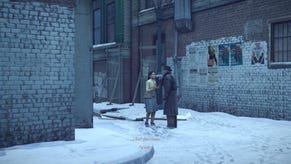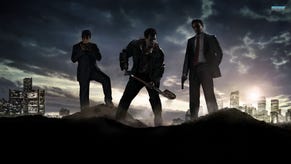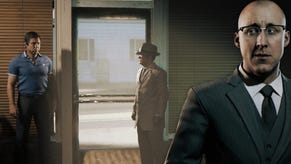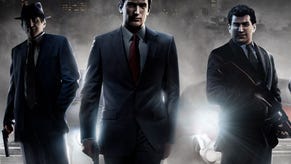Interview - Mafia II's Alex Cox and Jarek Kolar
VG247 was treated to a preview playtest with forthcoming 2K Czech blockbuster Mafia II at a press event in London earlier this month. We also managed to sit down for an interview with 2K producer Alex Cox and senior gameplay producer Jarek Kolar. Playing games and interviewing people: all in one day.
The main thing we took away from playing the four preview levels, including the superbly-paced intro level ‘Home Sweet Home’, is that they set the overall ambience of the game perfectly. They introduce you to the characters, the storyline and let you drive and shoot your way around the beautifully realised, New York inspired Empire Bay.
The driving, combat and shooting systems are intuitive and quick-to-learn. But it was the wisecracking dialogue between the game's main characters that really made the preview build stand out for us.
The game’s producer told us that Mafia II has been in "active development" for around five years, with a few years of "pre-production work" before that. It’s basically been stuck in development hell for the best part of a decade. Was it worth it? Is Mafia II going to be the ultimate interactive gangster flick when it releases on PC and console later this August?
Let's see.
VG247: Can you tell us about the story? Who wrote it?
Alex Cox: The story was written by Daniel Vavra and was inspired by real, historical events and classic Hollywood gangster movies, such as Goodfellas, Casino and The Godfather trilogy. The key is to create characters that are likeable.
Jarek Kolar: The story had a lot of iterations and we really tried to combine the story-telling with the gameplay in a way that hasn’t been done before. It took us some time to get to where we are now.
Also, the American guy [Jack Scalici] that wrote the Americanised version of the dialogue played a key role in telling the story, particularly as he is Italian-American and from New York, which I hope comes across in the dialogue – particularly between Vito and Joe, because their friendship is really the key to the story.
I mean, they come across as friends, right? They are two believable and plausible guys who live in a New York-style city and they have this Italian-American rapport that we all instantly recognise from modern movies, quick-witted with very funny turns of phrase. Good story-telling in games is about writing, directing and acting.
Alex Cox: It all comes down to plausibility. That they seem like real human characters and not like game constructs, which is all down to the amount of attention we gave to the writing and to the dialogue and characterisation. It is a believable story, you can engage with the characters and the player really does feel like they are playing the lead character in a movie such as Goodfellas. This is important to us as an idea.
The banter between Vito and Joe is clearly the most important aspect of that first Home Sweet Home chapter.
Alex Cox: Joe is a funny guy. He genuinely is entertaining and, I have to say, with all due respect to other games, there are very few games that have made me genuinely laugh out loud in this way. You genuinely find comedic characters in games to be excruciatingly poor.
Such as?
Alex Cox: [Laughs] I’m not going to give you any examples. It’s not my role to criticise other works. But Joe is very much like Joe Pesci’s character in Goodfellas. And he is equally as successful as a character, in that he is engaging and he is believable, which I think is a great achievement. To return to your original question about the details of the story and the background to the characters, you’ve seen at the start of the game that Vito comes home from the war. And the prologue tells you how he met Joe as a child and how they are long-standing childhood friends.
Vito gets arrested for a crime and gets given the option to either go to jail or to get conscripted into the army. He chooses the latter. He then arrives at the beginning of the game in the in-game city of Empire Bay in the wintry backdrop of late World War II, around 1945. He gets injured out of the army and comes home, where he finds himself in a difficult situation, in that his family are in a lot of debt and he needs to earn money fast. He’s not really got many prospects. Plus, he’s always had a bit of a chip on his shoulder, because his whole life as an Italian American immigrant has been lived in poverty up until this point, ever since he was a young child. So he wants a slice of that nice wealthy lifestyle that he sees others living. He wants attractive women, and so on.
What’s the inspiration behind Vito’s character and behind this key driving element to the 1940s storyline?
Alex Cox: Well you could call it a rags-to-riches tail, but that would make it sound a bit more generic than it is. We're trying to make references to people’s perceptions of Mafia fiction. We want Vito to seem like the main character in a mob movie. He’s been written and created as a guy to fulfil that role.
Jarek Kolar: Also, we really try to tell the story in the gameplay. I mean, for sure, there are a lot of games that are doing good and compelling stories, but then they switch from the cut-scene and they go into gameplay and the whole storytelling aspect and the narrative is gone. What we try to do is to really merge these two things together. You go from cut-scenes, where we really use camera angles and facial expressions to give details about the story, then it goes smoothly into gameplay, where these guys keeping talking and animating themselves in a ‘cut-scene’ way, but you're there playing and it creates an immersion that is really remarkable and connected.
Whenever you see another cut-scene you don’t feel like it is an interruption of your gameplay, but it is just like some moment when the game wants to show you something a little bit more specific or in a bit more detail.
Alex Cox: Vito’s position in life, when he comes back from the war, is pretty bleak. There are two reasons why this is important to the story. Firstly, we want Vito’s character to be able to plausibly and realistically kill people. It is part of the story and part of the gameplay, and his army training and his history in the army was written into his back-story as a reason. He can be presented with a “kill this guy” situation and his reaction is immediately, “OK.” It’s not like he has any serious emotional issues with this.
Secondly, there's the wintery backdrop, that depressing austerity of 1945 America, when a lot of the younger guys were away at war, people were on rationing, people’s loved ones were dying far away in foreign countries. Its winter, it’s cold, everybody is shivering in the streets and Vito’s life isn’t so great.
We then move into the 1950’s period in the game when Vito gets made, gets what he thinks is going to fix his life – money, women, cars and all of those things – and it is sunny. It’s summertime, you have a rock ‘n’ roll soundtrack and a completely different vibe. And this is a perfect example of how the game reflects and supports the story.
How does that shift happen? From the bleak 1940s to the rock ‘n’ roll, neon-lit 1950s?
Alex Cox: It is a gradual shift. I mean, the difference between missions might only be a week or a day, or it might be a month or a year. If you imagine each mission to be like a day in Vito’s life, they're just taken at this kind-of ‘snapshot moments’ throughout this ten-year period.
On average how long is it going to take to play through the entire game?
Alex Cox: Well the critical path gameplay, including cinematics, is around 15 hours. At least, that’s what we’ve seen from the focus testing.
In terms of this achievement with Mafia II, seguing from cut-scenes into gameplay smoothly – why do you think so many games still fail at this? It is why most gamers hate cut-scenes?
Alex Cox: I think it all comes down to narrative, exposition and quality of storytelling, and, Primarily, logic and believability of the storyline and of the characters. If you, as the game developer, are forcing me, as the player, to experience a narrative then you had better be damn sure that it is presented well and that it is very high quality. And if you look at movies, for example, which movies feature in our top tens?
They are all logical and believable and they have great engaging characters and highly dramatic storylines. And, they might have great special effects as well. But that seems to be priority number one for a great number of games. In great movies, all of the narrative stuff delivers too.
The difference is whether or not you respect the player enough to make them think it's believable and plausible, or whether or not you don’t actually mind them saying, “Well, whatever; it’s a game.”
As soon as people say, “It’s a game, so it's fine to have a crap story,” then players are going to have a crap response to that. They are going to say, “Well, you are making me experience that, you are making me do that, so you had better make sure that it is good quality otherwise I’m not going to enjoy it.” That can apply to cut-scenes or to awful in-game dialogue or awful scenes and unbelievable moments and plot twists.
Let’s talk about the music. It's superb. It seems like you have maybe made a conscious decision to spend a bit of money on licensing music for Mafia II, as opposed to licensing ‘real’ cars and weapons and other things. Is that the case?
Alex Cox: Well, in terms of money, if we thought anything was adding value, then we wouldn’t have been bothered about spending money. You are correct in that we have spent a lot of money in licensing music for the game; we have a list of over a hundred great tunes. But it is because that music is – for most gamers – a great way of creating this pretty stereotypical view of the 1940s and 1950s that we wanted to create. We're delivering what you expect of the 1940s and 1950s from watching movies and TV shows and things like that. Music is immediate. You hear rock ‘n’ roll tunes, your hear Bill Hayley, and you are immediately transported to the 1950s.
Also, as a secondary feature to the music, which maybe doesn’t come across until you play the whole game, is that when you are driving around in the city, the radio stations in your car all have specifically engineered tracklists for different points in the game. This means that when you are driving in-between missions, travelling around the city, the atmosphere in the game at that point – whether it is a happy time or a sad time or an action chase scene sequence or you are sneaking around – is reflected in the music.
The radio provides the score to the game, in very much the same way that a filmmaker such as Martin Scorsese will score his movies with pop tunes. You know, he has orchestral music – as we do – but the pop music is used to the same effect as it is in Mafia II. Happy tunes, sad tunes, fast tunes and so on. It is very subtle, but it reinforces the fact that the story is persistent.
The visuals in the game are also beautiful. Graphically it looks fantastic. But then haven’t we reached that point in the life-cycle now with the latest consoles whereby we expect that level of polish and graphical quality? Is this going to be out in 3D? What other types of ‘extra’ visual treats are you going to provide the gamer?
Alex Cox: 3D is on PC, yes. We have got various PC-specific features, as you would expect. Particularly, we have some cool stuff we’ve been developing with NVidia PhysX. In terms of the consoles, we don’t really have any sort of gimmick or anything like that which makes the game stand out from the rest. But it is a fair observation, that any games that have triple-A aspirations have to deliver high quality art. It is a given.
But what I would say is distinctive about Mafia II is that we do this high quality art in a tech way that is very much behind the scenes. We have seamless streaming between interior and exterior environments, so if there is any loading time it is almost minute, from going inside an amazingly-realised interior environment to a beautiful exterior cityscape. To the gamer, it's invisible. But to the coder is certainly not invisible. This is stuff that we have had to spend a lot of time doing. Working with the engine so that we can have as seamless an experience as possible, while doing all the other stuff such as fully destructible environments and the like, that people want to see from the game. It’s hard work.
Jarek Kolar: Also, it is not only how it looks, but also how it feels, how it is animated and also how you can interact with it. If you watch a film, you cannot touch it. But in the game you can check it out from every angle, you can shoot at it; all these types of things. And if they have the proper reaction you'd expect, then it creates a much better illusion of reality that if it was merely super-realistically detailed but you couldn’t touch it. And this is another aspect where there is still a lot of space for improvement for games in general. We may say that we have reached this level of beautiful visual quality, but now the difference is between how the environment changes, and how you can interact with it and with the in-game characters.
A lot of people do still see 3D as a gimmick. What might it add ‘beyond’ being a gimmick?
Jarek Kolar: First of all, I would say that 3D is the new thing for movies right now. But in terms of games, it's a technology that has been around for a long time, since the birth of 3D games. I worked on games that had 3D – with the glasses and everything – back in 2003. It's technologically possible because the space is rendered in 3D in real-time, so if you have the proper drivers and hardware it can give you this feel. And in terms of perception you can also take the example of audio and surround sound, which is great, gives a better feeling of immersion in the game.
Alex Cox: None of these things can ever really be more than a gimmick until somebody creates games that use these features as a core gameplay mechanic. I’m not sure whether or not some of these 3D technologies can add that right now. All they seem to add is some increased level of visual immersion in the game, to break down your barrier with your screen. Which is a subtle thing, similar to playing with surround sound. But these are small things, until somebody does something genuinely using 3D tech that can only be done in a 3D game…
And what about Microsoft Kinect, PlayStation Move and other new motion control technologies?
Jarek Kolar: These controllers are about interface and about communication between the player, between his mind and the game. What is important is that the player will not feel the interface. This can only work when the connection between your brain and the game is not obstructed by some device or complicated controller. These new ways of controlling can only really work if they keep the interface hidden from your perception.
Alex Cox: And can I also say, for sure, that you will never be able to make a game like Mafia II in this way using these types of technologies. It is a different genre. It is a different type of gameplay.
And I certainly don’t see them as mutually exclusive. I don’t think motion control is going to ‘kill’ traditional gaming, or anything like this. But I just thing that there will be a sort of game controller that is great for games like Mafia II, while things like mouse-and-keyboard are still great for RTS. Different genres will emerge from these new control technologies.
The one thing that really stood out for me, as well as the humour - from Joe, in particular, who does make you laugh out loud quite a lot - is the fact that the repetition of the dialogue doesn’t seem to present a problem. Because it is funny. Because you like to hear your favourite quotes again.
Alex Cox: Yeah. I mean, we’ve seen these demos hundreds and hundreds of times over and it's still funny for us. I play the game now, and I still smile widely at some of these incidents and interactions between Vito and Joe and other characters. Joe is the guy, this is his role – he is this real clown-like character.
What’s your favourite quote from Joe in the game? I’ve just scribbled down one here which made me laugh. He’s talking to Vito about women and he tells him: “When you measure seven soft, you don’t have to try.”
Alex Cox: [Laughs] Probably that one.
Mafia II is out on PC, PS3 and Xbox 360 on August 27.






